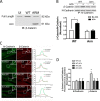Recruitment of β-catenin to N-cadherin is necessary for smooth muscle contraction
- PMID: 25713069
- PMCID: PMC4423682
- DOI: 10.1074/jbc.M114.621003
Recruitment of β-catenin to N-cadherin is necessary for smooth muscle contraction
Abstract
β-Catenin is a key component that connects transmembrane cadherin with the actin cytoskeleton at the cell-cell interface. However, the role of the β-catenin/cadherin interaction in smooth muscle has not been well characterized. Here stimulation with acetylcholine promoted the recruitment of β-catenin to N-cadherin in smooth muscle cells/tissues. Knockdown of β-catenin by lentivirus-mediated shRNA attenuated smooth muscle contraction. Nevertheless, myosin light chain phosphorylation at Ser-19 and actin polymerization in response to contractile activation were not reduced by β-catenin knockdown. In addition, the expression of the β-catenin armadillo domain disrupted the recruitment of β-catenin to N-cadherin. Force development, but not myosin light chain phosphorylation and actin polymerization, was reduced by the expression of the β-catenin armadillo domain. Furthermore, actin polymerization and microtubules have been implicated in intracellular trafficking. In this study, the treatment with the inhibitor latrunculin A diminished the interaction of β-catenin with N-cadherin in smooth muscle. In contrast, the exposure of smooth muscle to the microtubule depolymerizer nocodazole did not affect the protein-protein interaction. Together, these findings suggest that smooth muscle contraction is mediated by the recruitment of β-catenin to N-cadherin, which may facilitate intercellular mechanotransduction. The association of β-catenin with N-cadherin is regulated by actin polymerization during contractile activation.
Keywords: Adherens Junction; Cytoskeleton; Excitation-Contraction Coupling (E-C Coupling); Signal Transduction; Smooth Muscle.
© 2015 by The American Society for Biochemistry and Molecular Biology, Inc.
Figures








Similar articles
-
{beta}-Catenin regulates airway smooth muscle contraction.Am J Physiol Lung Cell Mol Physiol. 2010 Aug;299(2):L204-14. doi: 10.1152/ajplung.00020.2010. Epub 2010 May 14. Am J Physiol Lung Cell Mol Physiol. 2010. PMID: 20472712
-
Role of the adapter protein Abi1 in actin-associated signaling and smooth muscle contraction.J Biol Chem. 2013 Jul 12;288(28):20713-22. doi: 10.1074/jbc.M112.439877. Epub 2013 Jun 5. J Biol Chem. 2013. PMID: 23740246 Free PMC article.
-
Rho kinase collaborates with p21-activated kinase to regulate actin polymerization and contraction in airway smooth muscle.J Physiol. 2018 Aug;596(16):3617-3635. doi: 10.1113/JP275751. Epub 2018 Jun 24. J Physiol. 2018. PMID: 29746010 Free PMC article.
-
Integration of Cadherin Adhesion and Cytoskeleton at Adherens Junctions.Cold Spring Harb Perspect Biol. 2017 May 1;9(5):a028738. doi: 10.1101/cshperspect.a028738. Cold Spring Harb Perspect Biol. 2017. PMID: 28096263 Free PMC article. Review.
-
A novel role for RhoA GTPase in the regulation of airway smooth muscle contraction.Can J Physiol Pharmacol. 2015 Feb;93(2):129-36. doi: 10.1139/cjpp-2014-0388. Epub 2014 Nov 25. Can J Physiol Pharmacol. 2015. PMID: 25531582 Free PMC article. Review.
Cited by
-
Focal adhesion kinase activation is involved in contractile stimulation-induced detrusor muscle contraction in mice.Eur J Pharmacol. 2023 Aug 5;952:175807. doi: 10.1016/j.ejphar.2023.175807. Epub 2023 May 24. Eur J Pharmacol. 2023. PMID: 37236435 Free PMC article.
-
Prorelaxant E-type Prostanoid Receptors Functionally Partition to Different Procontractile Receptors in Airway Smooth Muscle.Am J Respir Cell Mol Biol. 2023 Nov;69(5):584-591. doi: 10.1165/rcmb.2022-0445OC. Am J Respir Cell Mol Biol. 2023. PMID: 37523713 Free PMC article.
-
TET1 Regulates Nestin Expression and Human Airway Smooth Muscle Proliferation.Am J Respir Cell Mol Biol. 2024 Oct;71(4):420-429. doi: 10.1165/rcmb.2024-0139OC. Am J Respir Cell Mol Biol. 2024. PMID: 38861343 Free PMC article.
-
Cyanidin-3-O-glucoside inhibits the β-catenin/MGMT pathway by upregulating miR-214-5p to reverse chemotherapy resistance in glioma cells.Sci Rep. 2022 May 11;12(1):7773. doi: 10.1038/s41598-022-11757-w. Sci Rep. 2022. PMID: 35545654 Free PMC article.
-
Corneal Endothelial Cell Integrity in Precut Human Donor Corneas Enhanced by Autocrine Vasoactive Intestinal Peptide.Cornea. 2017 Apr;36(4):476-483. doi: 10.1097/ICO.0000000000001136. Cornea. 2017. PMID: 28181929 Free PMC article.
References
Publication types
MeSH terms
Substances
Grants and funding
LinkOut - more resources
Full Text Sources
Research Materials

